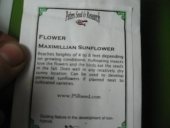




Bush morning glory, Man-root, Man-of-the-earth root, Wild potato vine, Wild jalap, Kahts-tuwiriki, Mecha-meck (Ipomoea leptophylla and/or I. pandurata).
A huge sweet potato-like root looms below long, trailing, low-growing vines with heart-shaped leaves and funnel-form flowers. Favoring the dry open range of sandy prairies as well as the banks of wallows
and roadsides east of the Rockies, one or the other of these two species can be found from southern Canada to Texas. Both of these morning glory species produce perennial roots that are sometimes shaped like a human body. When dug up, they stand thigh-high, and weigh forty pounds or more.
The Cheyenne, Arapaho, and Kiowa once used it as a survival food in drought years, but found it tough-skinned and exceedingly bitter if not carefully prepared and boiled. When roasted or baked, man-roots have the flavor of slightly bitter sweet potatoes. Neither delicacies nor staples, the starchy roots were also used medicinally to treat kidney, stomach, and urinary disorders and the seeds may have been consumed to induce visions.
 And where can I get some?
And where can I get some?
"Can be eaten if cubed and boiled in at least two changes of water. Never eat it raw. Younger and smaller is better. Young roots can also be roasted but they will be on the bitter side. Boiling twice is the preferred method, then roast the boiled cubes if you like. Usually straight down deep from where the vine goes into the ground you will find the root. Yard-long roots weighing 25 pounds are possible. But, they get more acrid the older they get so if you can find an big old one you might want to let it be and look for a smaller younger one nearby."
"Root - raw or cooked. Crisp, sweet and tender. Some reports suggest that the root is not very nice and was only used when nothing else was available, this is probably because old roots were tried. Roots should be no more than 3 years old, preferably only 2. Some native North American Indian tribes would use the root to store fire in the days before matches. They would start a fire in the root, wrap it up and hang it outside. It was said that the fire would keep for seven months.
Pecan Media: food forestry and forest garden ebooks
Now available: The Native Persimmon (centennial edition)
 1
1




Outdoor and Ecological articles (sporadic Mondays) at http://blog.dxlogan.com/ and my main site is found at http://www.dxlogan.com/









Pecan Media: food forestry and forest garden ebooks
Now available: The Native Persimmon (centennial edition)




This is not one to use medicinally unless you have excellent training. I might use it if I was on the verge of starvation, however I give plants that are strong medicinal's a wide berth when it come to edibility. Just the old wildcrafter in me, it demands respect.
Pecan Media: food forestry and forest garden ebooks
Now available: The Native Persimmon (centennial edition)








This species [(Ipomoea leptophylla] is common in sandy soil of the semiarid, central portion of the United States. It is a perennial with an enormously enlarged taproot, which is often 1 foot or more in diameter and tapers to 1 inch or less only at a depth of 4 to 6 feet. This enlarged portion of the taproot not only furnishes an enormous reservoir for food but also a storehouse of water upon which the plant may draw during a period of drought. The taproots extend to great depths, at least 11 feet and probably to twice this depth. Throughout their course they are profusely branched. Many of the branches penetrate obliquely outward or downward. Others pursue a nearly horizontal course. Many have an enormous spread, the roots running outward to distances of 15 to 25 feet or more. The surface foot of soil, as well as the 10 feet below it, is literally filled with the glistening white, brittle branches of this remarkable root system.
Pecan Media: food forestry and forest garden ebooks
Now available: The Native Persimmon (centennial edition)





|
Would you like to try a free sample? Today we are featuring tiny ads:
Christian Community Building Regenerative Village Seeking Members
https://permies.com/t/268531/Christian-Community-Building-Regenerative-Village
|




